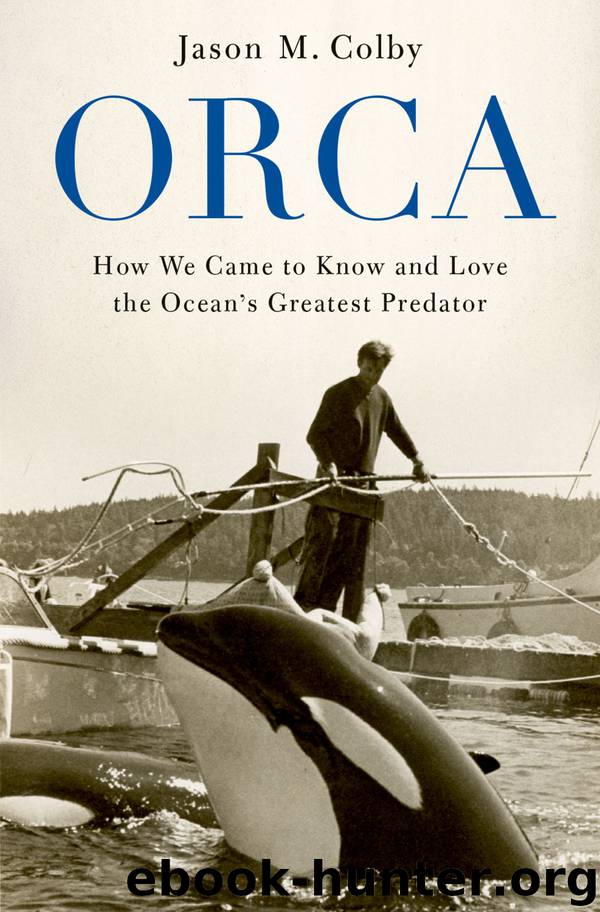Orca by Colby Jason M.;

Author:Colby, Jason M.;
Language: eng
Format: epub
Publisher: Oxford University Press, Incorporated
Published: 2018-07-28T16:00:00+00:00
Game Department officials in Washington State had no idea what they had gotten themselves into. From the moment the state legislature passed Bill 106, activists shifted their focus from Namu Inc. to the department itself. Although the Game Department would not officially assume its new duties until August 1971, Director Carl Crouse had already received an influx of letters urging him to refrain from issuing capture permits. Meanwhile, he and his staff scrambled to learn about marine mammals and the business of killer whale capture. Through the spring and early summer of 1971, they consulted frequently with Griffin and Goldsberry, and in this sense the legislation initially worked to the partners’ advantage. By using Namu Inc. as a template, the Game Department raised the barriers for other entrepreneurs who might consider catching the species. Yet, as activists pointed out, departmental officials still had no concrete data on the region’s killer whale population. And if they didn’t know how many there were, how could they issue permits? To answer this question, Crouse and his staff looked north.
That summer, the Game Department participated in the world’s first “killer whale census.” Organized by Michael Bigg, an innovative young marine mammalogist for the Canadian Department of Fisheries, the census enlisted the help of hundreds of US and Canadian volunteers to make a one-day head count of orcas on the Pacific coast.17 Conducted on July 26, 1971, the census resulted in a total of 549 killer whales spotted from Alaska to California. Most sightings occurred around Vancouver Island, with only 114 killer whales seen in Washington State waters—many of them reported by Griffin, who spent the day counting whales in Haro Strait. The numbers were lower than some observers expected, but that didn’t necessarily point toward prohibition of capture.18 No one knew if the killer whale population was static or fluctuating, resident or migratory.
The greater challenge was the identification of the individual animals. Without the ability to distinguish the orcas, scientists had no means to assess the species’ migration patterns or social organization, and thus no way to determine if the same groups of whales were being captured and culled repeatedly in the shared waters of Washington and British Columbia. To resolve this problem, researchers considered a variety of means to mark orca bodies. One strong possibility was freeze branding. Developed by Washington State University professor R. Keith Farrell, the method used a mixture of dry ice and ethanol to inscribe marks on animals. Initially conceived as a more humane means of branding cattle, it had recently been used by the US Bureau of Land Management to help monitor wild mustangs. With herds of mustangs frequently crossing the US-Canada border, officials wanted a means of both quantifying and laying claim to the animals as US government property. Washington State Game Department officials now hoped the method might be used to manage the region’s killer whales.19
Freeze branding initially enjoyed broad support. Griffin and Goldsberry endorsed it, as did Mike Bigg and activist-scientist Paul Spong in British Columbia.
Download
This site does not store any files on its server. We only index and link to content provided by other sites. Please contact the content providers to delete copyright contents if any and email us, we'll remove relevant links or contents immediately.
| Cell Biology | Developmental Biology |
| Entomology | Marine Biology |
| Microbiology | Molecular Biology |
| Biostatistics |
Sapiens: A Brief History of Humankind by Yuval Noah Harari(14259)
The Tidewater Tales by John Barth(12610)
Mastermind: How to Think Like Sherlock Holmes by Maria Konnikova(7236)
Do No Harm Stories of Life, Death and Brain Surgery by Henry Marsh(6891)
The Thirst by Nesbo Jo(6838)
Why We Sleep: Unlocking the Power of Sleep and Dreams by Matthew Walker(6620)
Life 3.0: Being Human in the Age of Artificial Intelligence by Tegmark Max(5480)
Sapiens by Yuval Noah Harari(5298)
The Longevity Diet by Valter Longo(5021)
The Body: A Guide for Occupants by Bill Bryson(4979)
The Rules Do Not Apply by Ariel Levy(4871)
The Immortal Life of Henrietta Lacks by Rebecca Skloot(4529)
Animal Frequency by Melissa Alvarez(4400)
Why We Sleep by Matthew Walker(4366)
The Hacking of the American Mind by Robert H. Lustig(4319)
Yoga Anatomy by Kaminoff Leslie(4310)
All Creatures Great and Small by James Herriot(4239)
Double Down (Diary of a Wimpy Kid Book 11) by Jeff Kinney(4210)
Embedded Programming with Modern C++ Cookbook by Igor Viarheichyk(4113)
